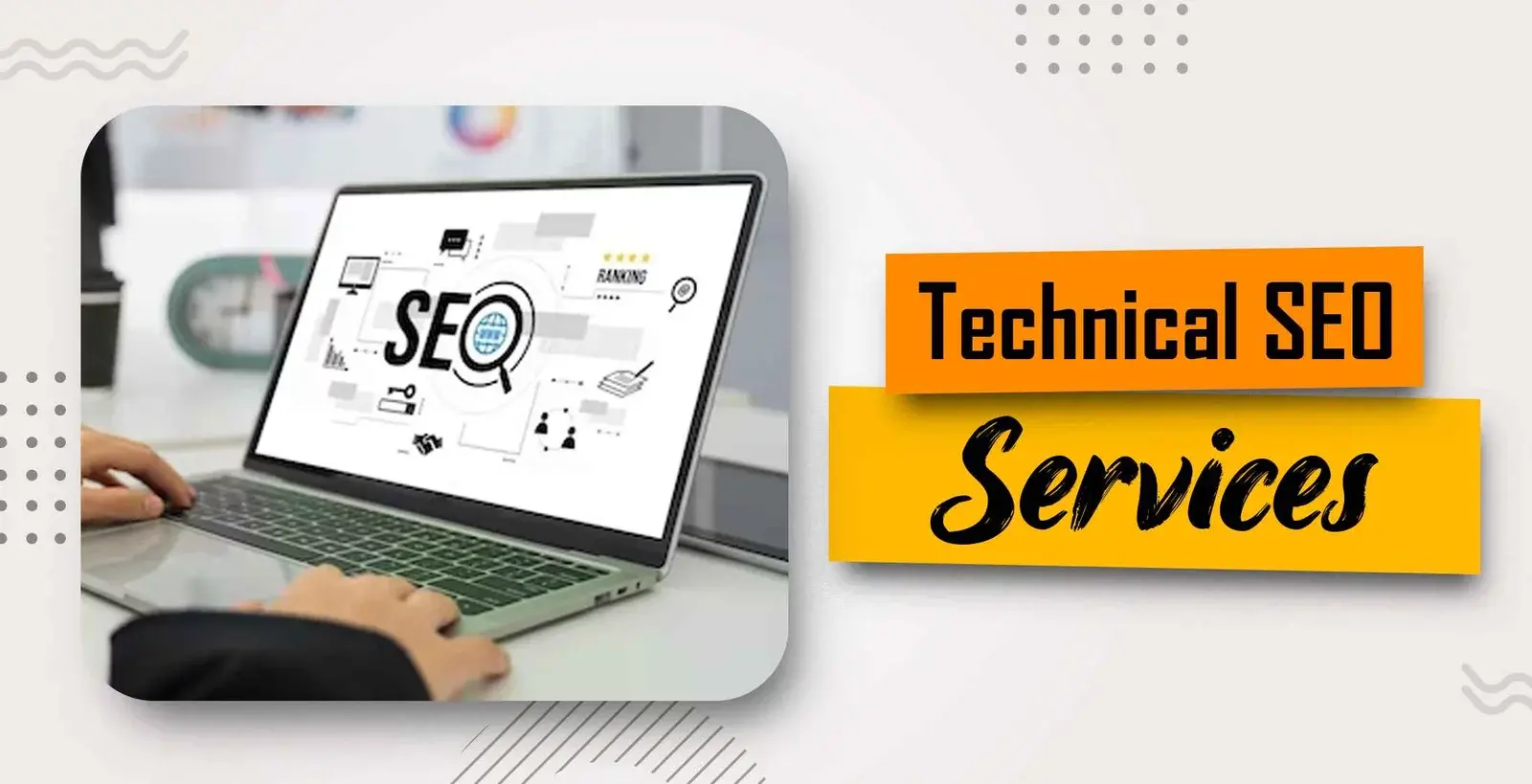In today’s digital landscape, achieving online visibility and success is intricately tied to effective Search Engine Optimization (SEO). Among the various facets of SEO, Technical SEO Services are pivotal in optimizing a website’s infrastructure for search engines. This roadmap will guide you through the complex and ever-evolving world of Technical SEO, shedding light on essential strategies, best practices, and the latest trends. By understanding the intricacies of Technical SEO, you’ll be well-equipped to enhance your website’s performance, improve its search engine rankings, and ultimately, drive organic traffic and success. Let’s embark on a journey of discovery and mastery in Technical SEO. What is Technical SEO? Technical SEO services refer to the specialized activities and strategies aimed at improving the technical aspects of a website to enhance its search engine visibility and overall performance. These services are typically provided by SEO (Search Engine Optimization) experts or agencies with a focus on the technical aspects of a website rather than its content or off-site factors. Some key aspects of technical SEO services include: 1. Website Speed Optimization Ensuring that web pages load quickly and efficiently, can improve user experience and search engine rankings. 2. Mobile Optimization: Make sure a website is mobile-friendly and responsive, as mobile-friendliness is a significant ranking factor for search engines like Google. 3. Crawlability and Indexability Ensuring that search engines can easily crawl and index the website’s pages, which involves optimizing the website’s structure, navigation, and XML sitemaps. 4. Site Architecture Organizing the site’s content logically and hierarchically to improve both user experience and search engine indexing. 5. URL Structure Optimizing URL structures for both users and search engines, including using descriptive and keyword-rich URLs. 6. Canonicalization Implementing canonical tags to prevent duplicate content issues and consolidate ranking signals. 7. Schema Markup Adding structured data markup to web pages provides search engines with additional information about the content, which can lead to rich snippets in search results. 8. Website Security Ensuring the website is secure using HTTPS and taking measures to protect against security vulnerabilities. 9. XML Sitemaps Creating and maintaining XML sitemaps to help search engines discover and index new pages on the website. 10. Redirect Management Managing redirects properly to avoid broken links, and ensuring that search engines understand the relationship between old and new URLs during website changes or redesigns. 11. Pagination and Parameter Handling: Dealing with issues related to paginated content and URL parameters, which can affect search engine indexing and user experience. 12. Server and Hosting Optimization: Ensuring that the website’s server and hosting infrastructure are reliable, secure, and provide good performance. What are the Important Components of Our Technical SEO Services? Important components of technical SEO services typically include: 1. Website Audit This involves a comprehensive analysis of your website to identify technical issues, such as broken links, duplicate content, and indexing problems. It helps in understanding the current state of your website’s SEO. 2. On-Page SEO Optimization This includes optimizing individual web pages to improve search engine rankings. It involves optimizing meta tags, headers, and content to make them more search engine-friendly. 3. Site Speed Optimization Improving website load times is crucial for both user experience and SEO. This may involve optimizing images, minifying code, and implementing content delivery networks (CDNs). 4. Mobile Optimization Ensuring your website is mobile-friendly is essential, as Google considers mobile-friendliness a ranking factor. This may involve implementing a responsive design or creating a mobile version of your site. 5. Schema Markup Adding structured data markup to your website can enhance the visibility of your content in search results, making it more appealing to users. 6. XML Sitemap and Robots.txt Creating and optimizing XML sitemaps and robots.txt files to help search engines crawl and index your site more effectively. 7. Canonicalization Properly handling canonical tags to prevent duplicate content issues. 8. URL Structure Optimization Creating clean, user-friendly URLs that contain relevant keywords and are easy to understand. 9. HTTPS/SSL Implementation Google has indicated that secure websites (using HTTPS) may receive a slight ranking boost. 10. International SEO (if applicable) Implementing hreflang tags to indicate language and regional targeting for international websites. 11. Technical Error Resolution Identifying and fixing issues like 404 errors, 301/302 redirects, and other technical errors that can impact user experience and SEO. 12. SEO-Friendly Structured Data Implementing structured data to enhance the appearance of your content in search results, such as rich snippets. 13. Crawl Budget Optimization Managing how search engine crawlers prioritize and navigate your website to ensure they focus on the most important pages. 14. AMP (Accelerated Mobile Pages) Implementing AMP for faster loading times on mobile devices. 15. SEO Reporting and Monitoring Providing regular reports and analysis of your website’s performance in search engine rankings and traffic. Why Partner with a Technical SEO Agency? Partnering with a technical SEO agency can be a strategic decision for businesses looking to improve their online presence and drive more organic website traffic. Here are some reasons why you might want to consider partnering with a technical SEO agency: 1. Expertise and Specialization Technical SEO agencies specialize in search engine optimization, particularly the technical aspects of it. They have in-depth knowledge and expertise in website architecture, site speed optimization, mobile optimization, and more. This specialized knowledge can help your website perform better in search engine rankings. 2. Staying Updated with SEO Trends SEO is a rapidly evolving field with search engine algorithms constantly changing. Technical SEO agencies stay updated with the latest SEO trends and best practices, ensuring your website adheres to the most current SEO guidelines. 3. Improved Website Performance Technical SEO agencies can identify and resolve issues that may be hindering your website’s performance in search engines. This can include fixing broken links, optimizing page load times, and improving mobile-friendliness, all of which can lead to better user experiences and higher search rankings. 4. Customized SEO Strategy A technical SEO agency can tailor an SEO strategy to your specific business needs and goals. They can conduct a thorough website audit to identify
In today’s digital landscape, where businesses are constantly vying for online supremacy, the importance of a strong online presence cannot be overstated. Your website acts as the digital face of your brand, and its visibility in search engine results can make or break your success. To sustain a competitive edge and ensure your website remains at the forefront of online visibility, it’s imperative to conduct regular SEO audits. In this fast-paced world of ever-evolving search engine algorithms and user expectations, this article will delve into why your website needs an SEO audit today. Discover how this strategic assessment can be the key to unlocking your website’s full potential and maintaining a competitive edge in the digital arena. What Is an SEO Audit? An SEO (Search Engine Optimization) audit involves a thorough assessment and analysis of a website’s performance in terms of its visibility and ranking across prominent search engines like Google and Bing. The primary goal of conducting an SEO audit is to pinpoint any issues, weaknesses, and potential areas for enhancement that may influence a website’s search engine rankings and overall online presence. Let’s delve into the essential elements and stages of an SEO audit: 1. Technical SEO Analysis This involves assessing the technical components of a website, including its site architecture, HTML coding, page load speed, mobile responsiveness, and other relevant factors. Technical SEO guarantees that search engines can efficiently crawl and index your website. 2. On-Page SEO Analysis This includes examining on-page elements like title tags, meta descriptions, header tags, keyword usage, and content quality. On-page SEO aims to optimize individual pages for specific keywords. 3. Off-Page SEO Analysis This looks at factors outside your website, primarily backlinks (links from other websites to yours). Analyzing backlinks helps determine the quality and quantity of external sites linking to your content. 4. Keyword Research and Analysis Evaluating the keywords relevant to your business or industry is essential. This involves identifying high-value keywords, assessing competition, and understanding user search intent. 5. Content Audit Review the quality and relevance of the content on your website. This may involve identifying duplicate content, outdated information, or gaps in your content strategy. 6. Local SEO Audit (if applicable) For businesses targeting local audiences, this includes assessing NAP (Name, Address, Phone number) consistency, local directory listings, and Google My Business optimization. 7. Competitor Analysis Examining your competitors’ SEO strategies offers valuable insights into effective practices within your industry. This process helps pinpoint potential areas where you can surpass their performance. 8. User Experience (UX) Analysis Evaluating the website’s usability, including page layout, navigation, and mobile responsiveness, to ensure a positive user experience. 9. Performance Metrics Tracking key performance indicators (KPIs) such as organic search traffic, click-through rates (CTR), bounce rates, and conversion rates is crucial for assessing the impact and success of your SEO strategies. 10. Recommendations and Action Plan An action plan is created based on the audit findings. This plan outlines specific steps and priorities for addressing the identified issues and opportunities to improve SEO performance. 11. Monitoring and Reporting After implementing the recommended changes, ongoing monitoring and reporting are crucial to track progress and adjust the strategy as needed. How to do an SEO Audit? Performing an SEO (Search Engine Optimization) audit is critical in optimizing your website’s performance on search engines like Google. It involves a comprehensive analysis of your website to identify issues and opportunities for improvement. Here’s a step-by-step walkthrough for performing an SEO audit: 1. Define Your Goals Determine the objectives of your SEO audit. Are you looking to improve your website’s organic search rankings, increase traffic, or boost conversion rates? Having clear goals will help you prioritize your efforts. 2. Crawl Your Website Use SEO crawling tools like Screaming Frog, Ahrefs, SEMrush, or Moz to analyze your website’s structure. This will provide a list of URLs, metadata, headers, and other on-page elements. 3. Keyword Analysis Evaluate your current keyword strategy. Are you targeting the right keywords, and are they relevant to your content? Use keyword research tools to identify high-potential keywords for your industry. 4. On-Page SEO Analysis Review the on-page elements of your website, including: Make certain that every page is finely tuned for a distinct set of keywords, ensuring that on-page elements are perfectly in sync with those chosen terms. 5. Content Quality and Relevance Examine the quality and relevance of your website’s content. Ensure that it is valuable, engaging, and informative. Look for duplicate, thin, or pages that can be consolidated or improved. 6. Site Speed and Performance Page speed is a critical ranking factor. Use tools like Google PageSpeed Insights or GTmetrix to assess your website’s loading times. Optimize images, enable browser caching, and minimize code to improve site speed. 7. Mobile-Friendliness Ensure your website is mobile-friendly. Google predominantly relies on the mobile version of a site for indexing and determining its ranking. Test your website’s mobile usability using Google’s Mobile-Friendly Test. 8. Technical SEO Analysis Investigate technical aspects of your website: 9. Backlink Profile Analysis Evaluate both the quantity and caliber of inbound links directed towards your website. Use tools like Ahrefs, Moz, or SEMrush to identify toxic backlinks and disavow them if necessary. Also, look for opportunities to earn high-quality backlinks. 10. Local SEO (if applicable) If your business has a physical presence, ensure your NAP (Name, Address, Phone number) information is consistent across all online directories and review your Google My Business profile. 11. Competitor Analysis Analyze the SEO strategies of your competitors. Identify keywords they’re ranking for and assess their backlink profiles. This can help you find opportunities to outperform them. 12. Analytics and Conversion Tracking Ensure your website has analytics tools (e.g., Google Analytics) installed to track user behavior and conversions. Analyze your data to spot patterns and pinpoint opportunities for enhancement. 13. Create an Action Plan Based on your audit findings, prioritize tasks and create an action plan. Address critical issues first and then work on improvements over time. 14. Monitor and Iterate SEO is an
In the digital age, brand visibility is no longer limited to traditional advertising avenues. Expanding one’s brand presence and credibility demands adaptive strategies, and guest posting stands at the forefront of these efforts. By contributing content to reputable platforms and blogs within your industry, you tap into their established audience and cement your authority in your niche. “Expanding Your Reach: How Guest Posting Can Elevate Your Brand” delves into the transformative power of guest posting, illustrating how it can foster connections, increase traffic, and elevate your brand’s reputation in a crowded marketplace. Dive in to unlock the potential of this influential marketing tactic. What is Guest Posting? Guest posting, or guest blogging, involves creating and sharing an article on another person’s website or blog. It’s a strategy bloggers and marketers use to increase website traffic, enhance their brand presence, and gain backlinks to their own sites. Here’s a more detailed explanation: 1. Purpose of Guest Posting a. Reach a New Audience: Guest posting allows a writer or a brand to reach a different audience they might not be able to tap into on their platforms. By writing for another blog, especially with a large or different audience, you can introduce yourself to readers who may not have heard of you before. b. Backlinks: One of the primary SEO benefits of guest blogging is acquiring backlinks. When composing a guest post, it’s customary to incorporate one or more hyperlinks leading back to your own website. These backlinks can help improve your site’s search engine ranking. c. Building Relationships: Guest posting helps build relationships with other bloggers and web admins. This can lead to other opportunities, collaborations, and a broader network in the blogging community. d. Establish Authority: Consistently writing high-quality posts for reputable sites can help establish you as an authority in your niche or industry. 2. How Guest Posting Works a. Finding a Suitable Blog or Website: You first identify websites or blogs that align with your niche or area of expertise. It’s beneficial if these sites have an engaged audience and good visibility in search engines. b. Pitching: Once you’ve identified potential sites, you typically send them a pitch. This is an email or message where you propose your guest post idea, provide a brief outline, and explain why it would benefit their readers. c. Writing the Post: If your pitch is accepted, you’ll write the post following the guidelines given by the host website. These guidelines might dictate the post length, the style, and the number of links you can include. d. Publication: Once you’ve written the post and it’s been approved, the host blog will publish it. They’ll often promote it on their social media channels, and it’s a good practice for the guest author to do the same. e. Engaging with Comments: Readers might leave comments or questions after the post is published. Engaging with these comments is a good way to connect with the audience and establish your presence. 3. Things to Consider a. Quality Over Quantity: It’s important to prioritize the quality of the blogs you’re posting on over the sheer number of posts. A well-crafted post on a reputable site can be far more beneficial than multiple posts on lesser-known or low-quality sites. b. Follow Guidelines: Always adhere to the guidelines provided by the host blog. This will ensure a smooth publishing process and maintain a good relationship for future collaborations. c. Avoid Spammy Practices: While backlinks are a significant advantage of guest posting, it’s essential not to be overly promotional or spammy. Concentrate on delivering authentic value to your audience. Are Guest Posts Bad for SEO? Guest posts, in themselves, are not inherently bad for SEO. Executing guest posting effectively can prove to be a valuable tactic for cultivating premium backlinks, amplifying brand visibility, and solidifying your expertise within your field. However, it’s essential to approach guest posting with the right intentions and practices. Here’s a breakdown of the potential benefits and pitfalls associated with guest posting: 1. Benefits of Guest Posting for SEO a. High-Quality Backlinks: A well-researched, relevant guest post on a reputable site can provide a high-quality backlink, boosting your site’s domain authority and overall search visibility. b. Brand Exposure: Guest posting can introduce your brand to a new audience, driving direct and referral traffic. c. Networking: Collaborating with industry peers can open up opportunities for further partnerships and joint ventures. d. Establish Authority: Publishing on reputable websites can position you as an expert in your field, fostering trust with audiences and search engines. 2. Potential Pitfalls of Guest Posting for SEO a. Low-Quality Websites: When engaging in guest posting on low-quality or spam-ridden websites, it can negatively impact your site’s credibility and may even result in penalties from search engines. b. Over-Optimized Anchor Text: Using an exact match or aggressively optimized anchor text can make your link profile look unnatural and can lead to penalties. c. Duplicate Content: Submitting the same article to multiple sites can lead to content duplication issues. d. Irrelevant Links or Content: If you’re posting content that isn’t relevant to the host site or your own site or embedding irrelevant links within the content, this can look manipulative. e. Purely for Link Building: If your sole purpose is to build backlinks without focusing on the quality of the content, search engines can view this as a manipulative tactic. 3. Google’s Stance In the past, Google has warned against “large-scale article campaigns” where people write articles, include a backlink, and then distribute them to many different sites. This warning is because such practices can look manipulative and lead to a dilution of content quality on the web. Getting Started with Guest Posting: Doing It the Correct Way Guest posting, when done right, can be a powerful strategy for gaining exposure, building backlinks, and establishing authority in your industry. But to ensure your efforts are effective and don’t backfire, you must approach guest posting carefully. Here’s how to start guest posting the right way: 1.
In the digital landscape, Search Engine Optimization (SEO) is important for getting many people to visit websites without needing to pay for ads. And within the SEO realm, on-page optimization is a crucial pillar. In this blog, we will explain how to optimize your web pages and rank higher on search engines. Following these tips and techniques can make the most of SEO and boost your online presence. Get ready to learn the secrets of on-page optimization and take your website to new heights. The Importance of On-Page Optimization in SEO (Search Engine Optimization) Is Significant for Several Reasons 1. Improved Search Engine Rankings By optimizing on-page elements such as meta tags, headings, keyword usage, and content quality, search engines can better understand and index your web page. This can help more people find your website when they search, bringing more visitors without paying for ads. 2. Enhanced User Experience On-page optimization focuses on improving the overall user experience by optimizing page load speed, mobile responsiveness, and navigation structure. When users have a positive experience on your website, they are likelier to stay longer, engage with your content, and convert into customers or subscribers. 3. Targeted Keyword Optimization On-page optimization lets you strategically incorporate relevant keywords into your content, headings, and meta tags. By aligning your page content with targeted keywords, you increase the chances of ranking higher for those keywords in search engine results. 4. Increased Click-Through Rates (CTR) Effective on-page optimization techniques such as compelling meta titles and descriptions can entice users to click on your search listings. A higher CTR indicates to search engines that your webpage is relevant and valuable, which can lead to improved rankings over time. 5. Better Content Visibility and Organization On-page optimization involves structuring your content logically and organizationally. This helps search engines better understand and organize your content, making it more likely to be seen as a highlighted answer or a special result. On-Page Optimization On-page optimization means changing individual web pages to make them appear more in search engine results and attract more visitors naturally. This involves improving the pages themselves and their underlying code to make them more relevant, user-friendly, and easily understandable by search engines. Here Are Some Key Components of On-Page Optimization: 1. Keyword Research Find the right words and phrases that people will likely use when searching for information about your website or business. 2. Title Tags Creating unique and descriptive title tags for each web page that accurately reflect its content and include targeted keywords. Title tags are displayed as clickable headlines in search engine results. 3. Meta Descriptions Write concise and compelling meta descriptions that summarise the page’s content and entice users to click through to your website. While meta descriptions don’t directly affect rankings, they can influence click-through rates. 4. URL Structure Ensuring URLs are clean, concise, and contain relevant keywords. A well-structured URL gives search engines and users an idea of what the page is about. 5. Heading Tags Use heading tags (H1, H2, H3, etc.) to structure your content and highlight important sections. Search engines use heading tags to understand the hierarchy and organization of your content. 6. Keyword Placement Strategically place keywords throughout your content, including in headings, subheadings, and body text. However, it’s essential to maintain a natural and user-friendly flow while avoiding keyword stuffing. 7. Content Optimization Creating high-quality, informative, and engaging content that satisfies user intent. This involves addressing relevant topics, providing valuable information, and incorporating multimedia elements such as images, videos, and infographics. 8. Internal Linking Linking to other relevant pages within your website using descriptive anchor text. Internal links help search engines discover and navigate your website and enhance user experience by providing additional information. 9. Image Optimization Optimizing images by reducing file sizes, using descriptive filenames, and adding alt tags. Making your images better helps your website run faster and makes it easier for search engines to understand what your images are about and why they’re important. 10. Mobile Responsiveness Ensuring your website is mobile-friendly and displays properly on different devices and screen sizes. Mobile responsiveness is crucial for user experience and search engine rankings as mobile usage continues to rise. Analysis and Monitoring as Prerequisites for Onpage Optimization Analysis and monitoring are essential prerequisites for effective on-page optimization. They provide valuable insights and data that inform the optimization process, enabling website owners and marketers to make informed decisions. Here’s a crisp and creative explanation: “Imagine your website is a high-performance race car; on-page optimization is the key to unlocking its full potential. But before you hit the gas pedal, you must analyze and monitor every aspect of your car’s performance to ensure a smooth and successful ride. An analysis is like taking your race car to the garage for a thorough inspection. You examine its engine, tires, aerodynamics, and every detail affecting its performance. Similarly, with on-page optimization, you analyze your website’s structure, content, keywords, and user experience. By examining what your website does well and where it needs improvement, you can find new opportunities and learn how search engines see your site. Monitoring is like having a skilled pit crew constantly monitoring your race car’s performance during the race. They track its speed, fuel consumption, tire wear, and any signs of trouble. In the world of on-page optimization, monitoring involves closely monitoring your website’s performance metrics, such as rankings, traffic, bounce rates, and conversions. It helps you spot any issues, track the impact of optimization efforts, and make timely adjustments. By conducting in-depth analysis and diligent monitoring, you equip yourself with the knowledge and insights to fine-tune your on-page optimization strategy. It’s like fine-tuning your race car’s engine, adjusting the suspension, and optimizing the aerodynamics for maximum speed and performance. With analysis and monitoring as your prerequisites, you’re ready to unleash the full potential of your website and leave your competitors in the dust.” Elements of On-page Optimization On-page optimization refers to the various techniques and practices used to optimize individual




